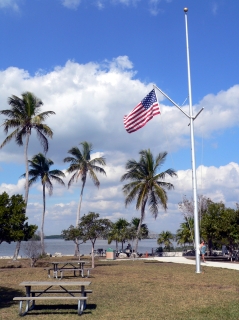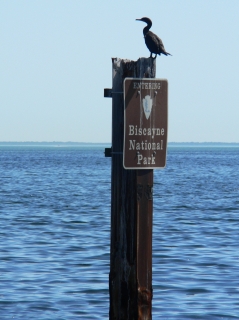NPS Website; Local Website

WHAT IS IT?
The northernmost Florida Keys, the water that surrounds them and the living coral reef that defines the Park’s western boundary. 95% of Biscayne NP’s 173,000 acres is underwater.
BEAUTY (7/10)
The Park enjoys the beautiful big blue sky of South Florida. The sparkling waters of Biscayne Bay stretch forever into the horizon. Our score represents the views from the coast, vistas that much of Florida’s Atlantic coast shares. We acknowledge that our score might have been higher had we had the opportunity to travel out to the Keys, snorkel in the crystal blue water and see the exquisite colors of a living reef and its finned inhabitants.
HISTORICAL INTEREST (3/10)
Biscayne NP is the National Park that lies closest to a major city. Its recent history is tied to the mushrooming population of Miami.
In the 1950’s, developers had wanted to build a causeway to the Keys that the Park now protects. If a causeway had been built, all of the Florida Keys would have been urbanized and the reef would, in all probability, resemble the heavily damaged and dying coral bordering the outer Florida Keys.
The story of the environmentalist struggle to preserve the last of South Florida’s wild barrier islands is compelling and told in an excellent 17-minute video at the Visitor Center. Biscayne NP seems to be the only place in Florida where real estate developers were held at bay.
The only remaining evidence of the planned urbanization of Elliott Key is a skinny clearing of trees that spans its length, nicknamed Spite Highway. As a last ditch effort to spoil the land for the National Park System, developers bulldozed a road, six lanes wide, through the island’s forest. Undeterred, the NPS named Biscayne NP a Park site in 1968. Rangers maintain a narrow portion of the bulldozed tract as an environmentally evocative hiking trail.
 CROWDS (7/10)
CROWDS (7/10)Biscayne NP feels very local, especially after spending any amount of time in the developed Florida Keys. The tourist trade feels non-existent despite the parking lot being full. We found dozens of locals fishing from a boardwalk and an extended jetty. They were a mix of age, background, language, gender and wealth, just like Miami. Others lounged around picnic benches soaking in the sun enjoying packed lunches.
A Ranger explained that Biscayne NP’s coral reef is the healthiest portion of Florida’s barrier reef despite being the closest to the Miami metropolis. We wondered why and he continued. The people who dive and snorkel Biscayne NP are mostly locals. They are familiar with how to dive and how to avoid the fragile coral. Fewer people snorkel here than off Marathon and Key West. The Park’s coral reef is fortunate that it receives little publicity.
The Park’s local clientele and relative obscurity does have its drawbacks. Snorkel trips leave daily, but depart only if there are six people willing to go. We arrived on a rare calm January afternoon. Snorkeling and visibility would have been perfect on the glassy waters. However, there was only one other couple who wanted to explore the reef. We were all out of luck.
EASE OF USE/ACCESS (1/5)
Only a miniscule portion of the Park is reachable without a boat; there is a small grassy shoreline and a short boardwalk and jetty near the Visitor Center. Biscayne NP’s inaccessibility is the secret to its charm as well as the source of much frustration. We would have liked to camp on Elliott Key, but without a boat we were unwilling to pay the $25.95 transportation fee.
Despite its relative proximity to Miami, the Park’s dock and Visitor Center is a lengthy trek from downtown, a 45 minute to an hour drive, via the crowded and circuitous South Florida highway system. The dock is five miles east of Homestead and Florida Turnpike Exit 6 (Speedway Blvd.), where SW 328th Street meets Biscayne Bay.
CONCESSIONS/BOOKSTORE (2/5)
Biscayne NP’s bookstore was stocked with more cans of bug repellant for sale than actual books. The usual laminated cards listing Florida’s birds, mammals, fish and coral were here, and a handful of other books which might be helpful to a novice birder. It’s selection was very similar to what we have seen at Big Cypress and the Everglades, probably since the Florida National Parks & Monuments Association manages all three.
We would have enjoyed more historical accounts of how Biscayne came to be, since the film introducing us to the battle between developers and Dade County commissioners was so interesting.
COSTS (1/5)
Biscayne NP has no entry fee but your visit could prove expensive. A 1½-hour snorkel trip costs $35 per person. Mask-fin-snorkel rental is an additional $10. Three-hour long glass-bottom boat tours leave daily at 10 AM and cost $25.45. Scuba trips occur only on weekend and cost $54. The concessionaire also rents canoe, kayaks and a variety of diving gear.
If you want to camp and are boat-less, a campground ferry costs $25.95, while the campsite is $10. If you are camping with motor craft, the overnight docking fee is $15.
RANGER/GUIDE TO TOURIST RATIO (3/5)
A volunteer introduced us to the site, but a Ranger was always in sight. When we finished watching the videos, one had just returned from taking a school group out on a walk and was there to answer all of our questions and point out a loggerhead shrike outside the window. Later, when Gab continued her quest to see an elusive manatee, a different Ranger confirmed the volunteer’s suggestion to try the nearby Mowry Canal. Rangers are always stationed on Elliott Key, near the halfway point on the Spite Highway. No manatees; plenty of Rangers.
TOURS/CLASSES (6/10)
Three films are shown on request. We requested two of them. One was an introduction to Biscayne NP, more of a marketing piece than an educational video, but it did give us an idea of what we might see if we had access to the reef.
The second film discussed in depth the creation of Biscayne NP beginning with the incorporation of Islandia, the proposed town that was to cover the keys now protected by the NPS. We wish there were films like this in all of the National Parks. How did the Park get here? What was the process? What were the debates? We really enjoyed learning about the people and conditions that made saving such a seemingly pre-destined piece of land and water possible.
The Visitor Center housed an impressive collection of well-preserved skulls. A huge sea turtle, manatee and alligator were all on display at the front desk. This is the closest we came to seeing any of these creatures at the Park.
The wildlife exhibit at the Visitors Center was a taxidermist’s dream. Almost a hundred different fish, birds, spiders, reptiles and mammals were on display here, amid replicas of native plants and coral. These visual aids acquainted us with the inhabitants of Florida’s Atlantic coast. We know this lesson will come in handy as we continue north through Canaveral National Seashore, Merritt Island National Wildlife Refuge and the Timucuan Ecological and Historical Preserve.
 FUN (6/10)
FUN (6/10)Since we were confined to the shoreline, we saw only 5% of what Biscayne NP has to offer. Plenty of other individuals were taking advantage of that 5%. Fishing, sunbathing, picnicking. Most of them seemed to be on their lunch break.
Biscayne NP didn’t feel like a National Park. It felt like a retreat, a respite from the large cities and the work week. The calming atmosphere was infectious and drove home the need for such a place amid sprawling metropolis and the burgeoning Keys.
We weren’t expecting to hear that the coral reefs were in such good condition. We had dismissed the idea of snorkeling before we arrived because we wrongly assumed that it would be among dead and colorless reef. The Rangers and the film corrected our assumptions, but because there weren’t six or more people ready to go out that afternoon, we could only imagine what we might have seen.
The mangrove coastline, the small beach, the jetty and the marina are far from lifeless. Fish, turtles, birds and supposedly a manatee with two calves make this area their home. We lingered around the marina and even took a drive down a dirt road to a nearby canal in search of a gentle giant, but to no avail. The chill in the air this week hasn’t helped Gab’s hunt. But there is still more of Florida to explore. She remains hopeful.
WOULD WE RECOMMEND? (6/10)
Biscayne NP is best appreciated with your own boat or means of getting out to the northern keys, and the sunken ships and coral reefs that lay beyond them. If you are boatless, be sure to arrive in time for the morning glass-bottom boat tour, or bring some friends to ensure a snorkeling trip in the afternoon. Follow the locals’ lead and bring a picnic lunch. Enjoy the view of the Miami skyline in the distance, a sharp contrast to the peaceful bay lapping on the shores.
TOTAL 42/80
www.usa-c2c.com
© 2004-06